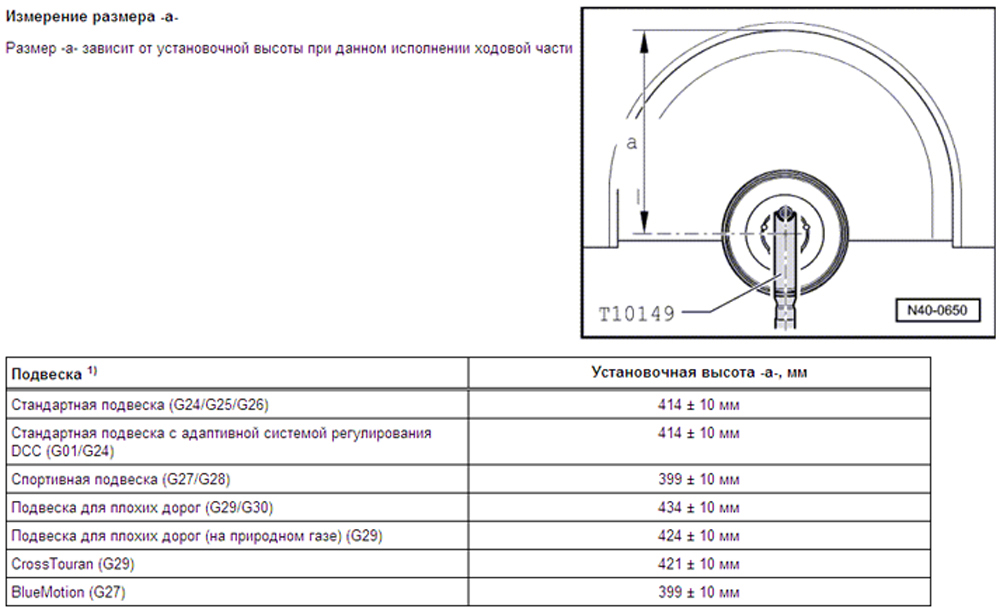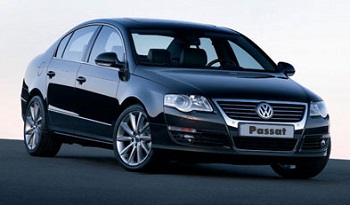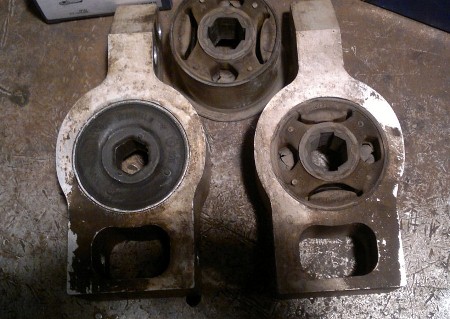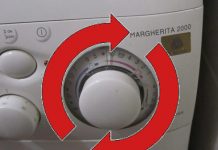In detail: do-it-yourself repair of the front suspension Volkswagen Passat B6 from a real master for the site my.housecope.com.
the multi-link suspension has a big advantage over the beam used on previous generations of VW. It improves handling, stability and comfort. But due to the sheer amount of detail, it can also be a weak point. Natural wear and tear of any (of the many) silent blocks turns the "assembled" machine into a roll barge that responds to the rut and profile of the road.
The weak points in the rear suspension include the front wishbones.
They have the smallest silent blocks with long suspension travel.
The most annoying thing is that it is not very easy to calculate their wear if you do not know how to check, where to look and what needs to be seen there. To begin with, the wear of the silent blocks in these levers gives the wheel some freedom of movement relative to the body.
only if you use two stops at once, you can unload these levers, and feel the bumpiness with your hands.
But there is another way to recognize a malfunction: hang the car and pull back the levers with a bar. Then you can see the peeling of the rubber
So, the verdict has been delivered. You can completely replace these levers on your own.
now in color pictures, and with slight simplifications. For example, it is not necessary to remove the springs at all.
-Before starting dismantling, it is necessary to clean and fill with a "liquid wrench" all the bolts
- the need to unscrew the stabilizer is due to the fact that the inner bolt abuts against it
but in fact, it is not necessary to unscrew the struts from the lever, the internal bushings are enough - from the body
by unscrewing the brackets, the stabilizer can be lowered, and it no longer interferes with removing the bolts
| Video (click to play). |
-Now you can unscrew the bolts of the levers
-take out the old levers, take out the new ones from the packaging. According to ELSA, they are symmetrical and non-symmetrical, i.e. left and right
before building, read ELSA again:

and again we pass from theory to practice:
-Selecting the correct lever, insert it into the frame
-If a new, but not the original, lever is installed, you can simplify the next replacement (which, of course, will soon be required) by inserting the inner bolts from the other side
-However, you first need to either shorten the bolt by 5 mm, or put another washer, otherwise the tip of the bolt will rest against the stabilizer
-insert the outer bolt. When the wheels are hanging, there is a divergence of the planes, so the bolt must be pulled down a little and at the same time push
- we press on several turns of the nut, but before tightening, you need to give the lever a position similar to the one loaded by the weight of the car
-that now you can tighten both lever bolts
-when both levers are hung out again, bait and tighten the stabilizer bolts
-Now you can tighten the wheels, lower the car and go straight to the camber / convergence stand. And rejoice that the car is going straight again, like a tram on the rails.
TenbOk »May 29, 2012, 20:07
TenbOk »31 May 2012, 13:21
andrey_020 »31 May 2012, 15:21
johnsit »31 May 2012, 19:33
TenbOk »01 June 2012, 00:22
andrey_020 »01 June 2012, 09:34
TenbOk »01 June 2012, 19:41
EroucT »12 June 2012, 10:31
A similar problem, I don't want to open a new topic. Please tell me.
In general, the whole rear suspension is thundering, I made diagnostics in a regular service, the master wrote what needs to be replaced.
Tell me by the numbers in the existential:
Stabilizer struts kit (right-left)
Stabilizer sleeves kit
Silent block of the lower arm 2 pcs. breakup + bolts, nuts, washers
Silent block of the lower arm, where the steering knuckle too
Silent block large on the front lever, longitudinal 2 pcs.
Well, I also think to change the racks at the same time at the rear, because one is exactly punched. which is better to put. so that it is not expensive and of high quality.
Machine 2.0 TDI 103 kW BPM 2008
and will it be necessary to do the collapse after replacing all of the above?
valent77 »12 June 2012, 11:13
Dmitriy »12 June 2012, 11:57
DenChik »20 Aug 2012, 20:36
EroucT »20 Aug 2012, 23:33
pva57 13 Dec 2012, 21:57
pva57 13 Dec 2012, 21:59
EroucT wrote: A similar problem, I don't want to open a new topic. Please tell me.
In general, the whole rear suspension is thundering, I made diagnostics in a regular service, the master wrote what needs to be replaced.
Tell me by the numbers in the existential:
Stabilizer struts kit (right-left)
Stabilizer sleeves kit
Silent block of the lower arm 2 pcs. breakup + bolts, nuts, washers
Silent block of the lower arm, where the steering knuckle too
Silent block large on the front lever, longitudinal 2 pcs.
Well, I also think to change the racks at the same time at the rear, because one is exactly punched. which is better to put. so that it is not expensive and of high quality.
Machine 2.0 TDI 103 kW BPM 2008
and will it be necessary to do the collapse after replacing all of the above?


Mdaa silent is a byad, good even if not under warranty, it is not expensive pleasure.
PS but VW has post-warranty support and, as it turned out, is not bad enough, it applies to almost all components and assemblies (including the suspension). but it all depends on the dealer.
above is written. (on the first screen.) - two levers
two wishbones with removable ball joints each
two stabilizer struts
subframe (also known as an attachment bracket)
two shock absorbers



I will also install these, and it’s time to change all the silent ones. I will put all the Lemforder, I have found all the numbers for the front and rear suspension. Here are just a lot of silencers produced in Turkey and China, the quality of which is worse than from the German plant. Whatever you run into when buying in China or Turkey, look for Lemforder details on the details and not on the packaging! "Owl"
On the details of Chinese or Turkish production there is a stamp: the letter L in a triangle or in the common people "leftist"



As time goes on, the time comes to replace the silent blocks of the rear suspension. My mileage is not small 140,000 thousand km. A couple of months ago, during the diagnostics, they sentenced me to all the rear suspension bushings. Yes, I myself guessed that the machine no longer drives so well and needs repair. Well, I began to select parts for replacement and immediately ran into the fact that the main levers are only assembled and in the original there are no separate silent blocks
There is this silent block 29917 01
These silent 29918 01
These silent 29314 01
There is an original silent 1K0 505 541 D and Lemferder 35451 01
The next one is not quite a lever but a hub
For him there is also the original 1K0 505 553 A well and Lemferder 27306 01
It is also necessary to replace the stabilizer link
Lemferder 26775 02
Original 1K0 505 465 K
And replace the stabilizer bushing
Only original 1K0 511 327 AS, AR, AQ depending on car
Another interesting thing is that on all Lemferder silencers that I received, the original VAG catalog number was stamped out, but when I tried to order using this number, it was reported that this part was not supplied.
If interested, I will make a report on the front suspension.
The device, service, repair and operation of Volkswagen Passat B6 cars with gasoline engines: BSE / BLF / BLP 1.6 l FSI (1595/1598 cm³) 102-115 hp / 75-85 kW, BLR / BLX / BLY / AXX / BWA 2.0 l FSI / TFSI (1984 cc) 150-200 hp / 110-147 kW, AXZ 3.2 l (3168 cc) 250 hp / 184 kW and diesel BKC / BLS 1.9 l (1896 cc) 105 hp / 77 kW, BMP / BKR 2.0 l (1968 cm³) 140 hp / 103 kW. Study guide, wiring diagrams, control dimensions of the body Volkswagen Passat station wagon (variant), sedan (limousine) model B6 release since 2005
The VW Passat is equipped with an electronically controlled parking brake as standard. In addition, thanks to the networked control, which unites all controllers and control units of the vehicle, other functions can be realized, for example, the function of holding the vehicle when stopping on an incline without having to hold down the brake pedal ("Auto Hold"). The emergency brake booster takes full advantage of the anti-lock braking system (ABS) to maximize braking force when the brake pedal is firmly applied. The brakes are equipped with a vacuum booster. All wheel brakes are disc brakes. The ABS system is installed as standard.
Vehicle stability control systems (ESP, EDS, ASR) can be installed as optional equipment. A system of access to the car, starting and stopping the engine without the direct use of a key (KESSY) is offered as an option. The VW Passat is equipped as standard with front and side airbags for the driver and front passenger and emergency seat belt pretensioners. Additionally, you can install side airbags for rear passengers and inflatable curtains.
The manual is compiled on the basis of the experience of the workshop and contains technical specifications, descriptions of the repair of individual components, a section on troubleshooting and recommendations on the maintenance of VW Passat B6 vehicles. A separate Chapter is intended to familiarize the owner of the car with the controls and techniques for safe operation. For car owners and auto repair shop workers.
Various types of suspensions are available for the vehicle as additional equipment. The suspension type is indicated by a PR number. The PR number of the suspension can be found on the vehicle data plate located in the luggage compartment to the left of the spare wheel. Also, the PR number is given in the car's service book.
The information is intended for models 2000, 2001, 2002, 2003, 2004, 2005 model year.
Pressing the upper arms out of the stub axle, see here
Removal and installation of the front lower arm see here
Replacement of front lower arm bushings see here
Removal and installation of the rear lower arm see here
Replacement of the rear lower arm bushing and anti-roll bar bushings, see here
Removal and installation of the upper suspension arms and replacement of the bushings of the upper arm supports, see here
Removal and installation of the stretcher see here
Replacement of the subframe support, see here
Removal and installation of the shock absorber, see here
Disassembly and assembly of the shock absorber, see here
Removal and installation of the pivot pin see here
Disassembly of the stub axle see here
Removal and installation of a semi-axle with hinges of constant angular velocities, see here
Semiaxis repair see here
Removal and installation of the rear axle beam and shock absorber spring, see here
Removal and installation of the hub unit see here
Repair of the undercarriage of the Volkswagen Passat B6, depends on the amount of work. Average repair of a Volkswagen Passat B6 suspension takes one day. If the undercarriage is in a deplorable state and gas and plumbing work is required, the undercarriage repair may take up to two days.
Service station on Grazhdanka - 603-55-05, from 10 to 20, no days off.
Service station in Kupchino - 245-33-15, from 10 to 20, no days off.
STO on Courage, 748-30-20, from 10 to 20, no days off.
WhatAapp / Viber: 8-911-766-42-33
Before repairing the Volkswagen Passat B6 chassis, we will make a free suspension diagnosis. As a result of diagnostics, we will indicate all types of work that need to be done. The critical points and those works that can be done later will be surely indicated. We will offer spare parts for the repair of the Volkswagen Passat B6 chassis from our warehouse and indicate their cost.
When repairing a chassis, we recommend combining a number of works to reduce the cost of repairs. For example: urgent replacement of front springs and non-urgent replacement of support bearings are required. In this case, it is better to replace both the springs and thrust bearings. the amount of work and its cost will be the same.
After some work on the repair of the chassis, wheel alignment may be required. You can also do this with us.
If spare parts for chassis repair are purchased from us, we will make job discount - 10%.
Warranty for work - 6 months, no mileage limit.

And what about the reliability of those systems that implement all these qualities? Let's deal with the problems in the transmission, electrical and suspension of the sixth "Passat": how often do you need "surgical" intervention?
Road sand-salt cocktails gradually disable the external electrics: parking sensors and backlighting of the rear numbers begin to "glitch".
However, that part of the on-board electrical network that is not exposed to external influences also does not shine with reliability.
The climate control system can bring a lot of unpleasant surprises. The fan motors of the heater can unpleasantly "sing" after 70-80 thousand km, the owners often changed them under warranty. If the climate system works intermittently, then the probable cause is the failure of the servos of the air duct dampers. Only their replacement will correct the situation.
The cars of 2005-2006. exhaust, there are problems with the air conditioning compressor.
Electric seat adjustment and heating, electric door locks and handbrake actuators usually do not last more than five years. Interruptions in the operation of the outside light are frequent: the turning mechanism of the adaptive headlights jams, diodes burn out in the taillights.
The electrician of the steering column lock is junk, and the replacement of the block will "result" in a decent amount.
Haldex coupling
In the 4Motion system, all-wheel drive is provided by the Haldex clutch. The "smart" electronically controlled device transmits torque to the front and rear axles of the machine in a ratio of 100: 0 or 50:50. In the first case, a full-fledged front-wheel drive is obtained, in the second - the moment is evenly distributed along the axes, like in an SUV.
The system does not cause problems before 250,000 km. To maintain it in working order, only regular maintenance is required: the oil in the clutch must be changed every 60,000 km.
More often it is worth paying attention to the condition of the internal CV joints - it is easier and cheaper to replace a worn boot than to change the joint itself.
"Mechanics" is preferable to automatic transmission: both the five-speed gearbox, which was installed on cars with a 1.9 diesel engine and a 1.6 MPI gasoline engine, and the "six-speed" of the rest of the configurations work smoothly. On a mileage of 70,000-80000 km, however, oil seals can leak, therefore, in order not to "ditch" the box, you need to watch out for the appearance of oil smudges.
With a low oil level in the gearbox on cars produced in 2005-2007, the shaft bearings "die" very quickly.
The six-speed Tiptronic transmission tends to overheat. The first victims of systematic overheating are the valve body and bearings - after 60,000-80000 km, gear shifting begins to be accompanied by blows. The hydraulic block will need to be changed (which is more expensive) or repaired, but the restored one does not last long.
The worst is the case with the DSG preselective robots.
"Wet" gearbox BorgWarner DQ250
The BorgWarner DQ250 is a six-speed wet clutch transmission. She became famous for her twitching when switching between first and second gears.The blows of an ordinary "machine gun" are also characteristic of it, only they begin much earlier - already from 20,000 km. And the reason is the same - the mechatronic valve body fails.
Calling the cost of maintenance and repair of the DQ250 democratic language does not turn out: replacing the "mechatronics" has a devastating effect on the wallet, and the oil in the box needs to be changed every 60,000 km (this requires 7 liters of expensive ATF DSG).
"Dry" gearbox DSG DQ200
This seven-speed transmission has Luk dry clutches. She was put on the "Passat B6", starting in 2008. Problems with the "mechatronic" she inherited. In addition, there were troubles with the work of the clutches. Jerks and jerks during switching frayed the nerves of all owners. In official services, in response to massive complaints, the ECU was reflashed, the clutch packages and the gearbox themselves were changed. However, after 40,000-50,000 problems returned regardless of the type of measures taken.
The manufacturer managed to modify the box only at the end of 2010. The new version received reinforced clutches and an improved control unit. In practice, only the owners of the next generation of Passat could appreciate the improvements. However, Volkswagen honestly acknowledged the design flaws of the unit and extended the warranty on the DSG DQ200 to 5 years.
Both suspensions of the sixth "Passat" are independent: front - with MacPherson struts, rear - multi-link.
Compared to the transmission, the Passat B6 suspension can be called problem-free. Its weak point is the site blocks in the front levers. On machines of the first three years of production, their resource did not exceed 20,000-30,000 km.
In 2008-2010 cars, the suspension is better, it starts to get tired after 100,000 km. On this run, the silent blocks of the levers, front shock absorbers, steering tips, stabilizer struts "end". Bulkhead suspension will require a lot of investment, especially if you use original parts.
"Passat B6" turned out to be a difficult child for Volkswagen, especially the cars of the first years of production - they got a whole bunch of "childhood illnesses". The manufacturer managed to overcome some problems, so cars produced in 2008 and later are technically more reliable than copies of 2005-2007.
However, the robotic gearbox (both six- and seven-speed), the main source of problems for the sixth "Passat", has remained the Achilles heel of the "people's" German car.
Many elements of the front wheel suspension can be independently removed and reinstalled. For certain work, you still need tools from the workshop. In no case should the damaged parts of the suspension be straightened, let alone welded, they must be fundamentally replaced with new ones.
Removing the front suspension strut
Removing the shock absorber at the top. After removing the cover (1), you can loosen the suspension strut mounting nut using a spanner wrench (3). To do this, hold the shock absorber rod with an Allen key (2).
Removing the shock absorber at the bottom. Shown are the stabilizer link bolts (1) and the wheel bearing housing bolts (2 and 3).
When removing the shock absorber, you should take into account: if you disconnect it from the wheel bearing housing, you will have to re-adjust the wheel alignment angles, which is possible only on a measuring stand in the workshop.
For this reason, we describe here the removal of the shock absorber strut together with the wheel bearing housing.
Another addition: to tighten the upper nut of the shock absorber strut, mechanics in the workshop use a VW 3078 socket wrench.
- Purchase a new self-locking nut and a new swing arm clamping bolt.
- With the vehicle standing on the ground, loosen the central securing bolt of the drive shaft in the wheel hub (center of the wheel).
- Loosen the wheel bolts.
- Raise the vehicle evenly at the front to avoid stress on the stabilizer bar. Secure the vehicle.
- Remove the wheel.
- Disconnect the stabilizer link from both suspension struts, press the stabilizer up.
- Disconnect the disc brake caliper and secure it to the body with a wire - the brake line remains connected.
- Disengage the track rod joint.
- Remove the axle joint clamping bolt at the bottom of the suspension strut.
- Pull the pivot pin out of the strut using a pry bar. This separates the strut and the wishbone. In this case, under no circumstances should the slot in the wheel bearing housing be widened, for example with a screwdriver.
- Unscrew steering wheel and remove drive shaft from wheel hub.
- Remove the cover from the shock absorber cup in the engine compartment.
- Remove the nut of the suspension strut from the top of the rod. To do this, hold the stem with an Allen key.
- While doing this, hold the shock absorber strut underneath.
- Pull out suspension strut downwards and at the same time remove it completely from the drive shaft.
- For installation, use new self-locking nuts and a new clamping bolt of the suspension joint.
- Install the clamping bolt so that its head points forward in the direction of travel.
- Tightening torques: nut of the upper fastening of the shock absorber strut: 60 N • m, nut of the track rod: 30 N • m, clamping bolt of the independent suspension joint: 50 N • m, connecting rod of the stabilizer on the shock absorber strut: 40 N • m.
- If the same shock absorber strut is installed and the bolts connecting the wheel bearing housing and the shock strut remain clamped all the time, then there is no need to adjust the wheel alignment.
Elements of the front suspension strut and the sequence of their installation
1 - spring;
2 - spring plate;
3 - suspension strut bearing;
4 - buffer;
5 - protective casing;
6 - threaded cover:
7 - shock absorber;
8 - 10 - spacer, cover.
Audi 80 front wheel suspension at close range
1 - the body of the shock absorber;
2 - bolted connections of the shock absorber housing and the wheel bearing housing;
3 - wheel bearing housing;
4 - axial hinge;
5 - clamping bolt;
6 - the lower transverse suspension arm.
Left: Tie brackets are required to separate the spring from the shock absorber when the strut is removed.
Right: The illustration shows the suspension joint clamping bolt (1) with which the suspension joint (3) is attached to the wheel bearing housing. Further indicated: the fastening nuts (2) with which the suspension joint is connected to the lower wishbone.
Replacing the front shock absorber
To carry out this work (with the shock absorber removed), a device for tension (compression) of the spring is required. You will need at least two pullers, even better three. Without the use of a spring tensioner, the spline nut at the top of the shock absorber rod must not be loosened, because the spring is in a state of strong pre-tension. Otherwise, the components of the shock absorber strut will fly apart as in an explosion - there is a great risk of accidents!
In addition, the uncompressed spring can no longer be reinstalled. Spring tensioners are available at parts stores. Next, you need the following special tools: a VW 524 wrench to loosen the spline nut and a 40-201 A tool to loosen the screw cap above the shock absorber. If you don't have them, you will have to help yourself with a large pipe wrench.
- Remove the suspension strut (see previous section).
- Clamp the shock absorber strut through the wooden wedges at the height of the steering knuckle arm in a vice. Never pinch the cylindrical section, otherwise you will crush the shock strut.
- Install the spring tensioner at the spring coils and compress it slightly.
- To prevent the spring tensioner from slipping, cover these turns with adhesive tape, if necessary.
- Now loosen the spline nut at the top of the suspension strut. Hold the shock absorber rod with a wrench.
- Remove the spring together with the suspension strut bearing and additional parts.
- Remove the screw cap at the top of the shock absorber.
- Pull out the shock absorber.
- The factory is fitted with liquid shock absorbers. In this case, you need to pour out the old fluid from the shock absorber (special waste!) And clean its stem.
- Install a new shock absorber cartridge without fluid.
- The installation sequence of the constituent elements is shown in the figure on the upper right. Next, note that the color coding of the springs indicates the bottom.
- Tightening torques: threaded cover of the shock absorber cartridge: 150 N • m, slotted nut on the shock absorber rod: 50 N • m.
Removing the front wheel bearing
The wheel bearing with its outer ring is pressed into the housing, the wheel hub is pressed into the inner ring. Under no circumstances should a new wheel bearing be driven into its place with a hammer, otherwise you will "install" the next damage together with the bearing. Therefore, it is better to remove only the shock absorber itself and disconnect the brake disc, as well as the casing. And you must entrust the actual removal and installation of the bearing to the workshop, which has a repair press at its disposal.
- Purchase a new self-locking nut and a new swing arm clamping bolt.
- Raise the vehicle evenly at the front to avoid stress on the stabilizer bar. Secure the vehicle.
- Remove the suspension joint clamping bolt at the very bottom of the suspension strut.
- Use a pry bar to press out the independent suspension pivot pin at the shock absorber strut. In this case, under no circumstances should the slot in the wheel bearing housing be widened, for example with a screwdriver.
- Mark the installation position of the pivot on the lower wishbone.
- Unscrew the axle joint securing nuts at the bottom from the lower control arm. Remove the hinge.
- When screwing on the axle joint, take into account the marks made when removing the mark; in this case, the adjustment of the wheel alignment angles will remain approximately the same.
- Do not forget the shims for the fastening nuts.
- Tightening torques: the nuts of the independent suspension joint must be tightened to a torque of 65 N • m, the nuts of the clamping bolt to a torque of 50 N • m.
- Carry out wheel alignment in a workshop.
Removing the wishbone
- All self-locking nuts will need to be replaced as well as the bolts connecting the wishbone supports to the axle beam.
The wishbone can be removed with or without the axle joint. Which bolts need to be loosened in one case or another, is described in the previous section. - Remove nuts for inner bushings for wishbone support.
- If the inner bearings of the wishbone have already worn out, then before installing the lever it is better to immediately press in (in the workshop) new ones.
- Installation: Fasten the wishbone from the outside to the wheel bearing housing or to the independent suspension pivot. You will find the tightening torques in the previous section.
- Tighten the nuts for the inner bearings of the wishbone loosely at first. Tighten fully only when the vehicle is on its wheels. Otherwise, the wishbone bearings may become skewed.
- Tightening torques for the nuts of the inner bearings of the wishbone: first
40 N • m, then turn another 1/4 turn (90 °).
The arrow points to the lower mounting bolt under the rear strut on front wheel drive models.
Top suspension strut mount on the rear axle for front-wheel drive models. The arrows point to the four strut mounting bolts, the number (1) indicates the strut itself.
Rice. 4.71.Tie rod and stabilizer
Unscrew the nut 1 and pull the connecting rod 2 out of the stabilizer (Fig. 4.71).
Remove the transverse link bolt 3.
Rice. 4.72. Stabilizer bracket retaining bolts
Unscrew the stabilizer bracket bolts (Fig. 4.72).
Unscrew the nut and remove the bolt towards the rear.
Rice. 4.73. Transverse link bolt
Remove the transverse rod 1 (Fig. 4.73).
Install the transverse link to the vehicle and hand tighten the bolts.
Tighten the tie rod only when dimension "a" has been reached.
Screw the tie rod 1 to the subframe and tighten the new nut.
Tighten the stabilizer bracket bolts.
Remove the transverse link bolt 3.
Note: Make sure a washer is installed between the nut and the wheel bearing housing.
Insert the connecting rod 2 into the stabilizer and tighten the nut 1.
Armed with forum knowledge, a 16 head and 16 keys, I went to a friend's garage to conquer the old suspension of my Folks and replace the levers, which had long been asked for replacement and were safely purchased in advance. For a week I spilled everything with kerosene, because I knew that knocking out the bolt fixing the upper levers was simply unrealistic. And I was waiting for the most severe bummer, the suspension is all native and for 10 years the bolt just adhered to the car. I could not unscrew it. On the other hand, I broke and drilled, drilling killed me altogether. In general, it was not for nothing that the hodovka was nicknamed “the revenge of the fascists” ... I went to the masters, I thought that there was some kind of miracle remover and special sprays, a liquid key or hellish acid. It turned out that everything is prosaic. For almost an hour, the hard worker stood and hammered the bolt with a hammer, pouring water on the WD-shko. Eventually the bolt gave in and fell out, no miracle or gimmick, just brute force. I knocked out the levers with a hammer, I hoped that at least there would be a puller.
Further already like clockwork. They removed the levers, unscrewed the stand, took it out on the table and calmly changed the levers, and then everything was in place. I smeared the graphics so that the bolts could be knocked out calmly through some kind. The levers are nice, white and green bolts / nuts. I ordered DAKAtec 8 levers + 2 stabilizer struts + 2 tie rod ends + a set of bolts for everything. Everything in a package, in a foil in a box, molding, not otherwise.
Replacing the bottom of the stabilizer link was already independently, changed in 5 minutes. At least there are no pitfalls: he raised the car on two jacks, removed the traction, added new ones, lowered the car, tightened it and that's it. And they asked the locksmith for this 1300re ((I roll out of the garage to the collapse - full of joy pants. In general, the suspension now works the way the Germans wanted it, when developing the car, namely perfectly!
For repair we have a Volkswagen Passat B6 car, 2 liters, automatic, manufactured in 2007, on it we will need to replace the front ball joint, we will show instructions on how to do it with our own hands correctly.
How to understand that the ball joint is out of order on your car, you can raise the front part and turn the steering wheel, you will hear characteristic dull knocks, at the very beginning of the video you can hear them. We start repairing.
We lift the car, remove the front wheels. We unscrew three nuts by 16 and from above by 18:
Our nut by 18 rested against the boot of the drive, we apply several biting blows to the place where the red circle is located in our photo:
In our case, everything worked out, if not, then we would have to unscrew the drive and use the pullers. The new front ball joints are from LEMFÖRDER, the number in the spare parts catalog for the right one is 2999902, the left one is 2999802. Each set should include three new fastening nuts. Before installation, we lubricate the threads with copper grease, this will allow you, during further repairs, to be guaranteed to unscrew all fasteners without any difficulties.
Video of replacing the front ball joint in the Volkswagen Passat B6:
Backup video how to replace the front ball joint Volkswagen Passat B6:
Repair of the undercarriage of the Volkswagen Passat B6, depends on the amount of work.Average repair of a Volkswagen Passat B6 suspension takes one day. If the undercarriage is in a deplorable state and gas and plumbing work is required, the undercarriage repair may take up to two days.
Service station on Grazhdanka - 603-55-05, from 10 to 20, no days off.
Service station in Kupchino - 245-33-15, from 10 to 20, no days off.
STO on Courage, 748-30-20, from 10 to 20, no days off.
WhatAapp / Viber: 8-911-766-42-33
Before repairing the Volkswagen Passat B6 chassis, we will make a free suspension diagnosis. As a result of diagnostics, we will indicate all types of work that need to be done. The critical points and those works that can be done later will be surely indicated. We will offer spare parts for the repair of the Volkswagen Passat B6 chassis from our warehouse and indicate their cost.
When repairing a chassis, we recommend combining a number of works to reduce the cost of repairs. For example: urgent replacement of front springs and non-urgent replacement of support bearings are required. In this case, it is better to replace both the springs and thrust bearings. the amount of work and its cost will be the same.
After some work on the repair of the chassis, wheel alignment may be required. You can also do this with us.
If spare parts for chassis repair are purchased from us, we will make job discount - 10%.
| Video (click to play). |
Warranty for work - 6 months, no mileage limit.

















